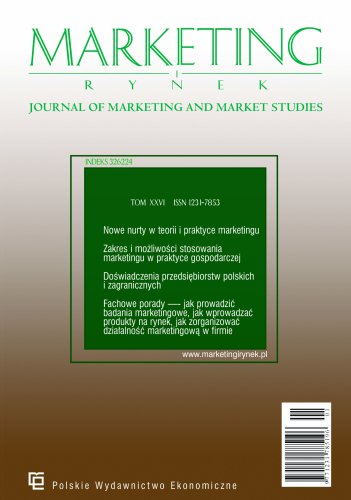Subkultury, społeczności w internecie versus społeczności wokół marki — ujęcie definicyjne
Termin społeczność na dobre zagościł w terminologii stosowanej przez środowiska marketingowe. Celem artykułu jest zaprezentowanie istoty pojęć: społeczność wokół marki, subkultura oraz społeczność w internecie i wskazanie konsekwencji dla świata marketingu wynikających z różnic zachodzących pomiędzy nimi.
Bibliografia
Bibliografia/References
Bagozzi, R. i Dholakia, U. M. (2002). Intentional social action in virtual communities. Journal of Interactive Marketing, 16(2). https://doi.org/10.1002/dir.10006
Bakeberg, B. (2016). Online brand communities: Value creating capabilities of brand communities on Facebook. Hamburg: Anchor Academic Publishing.
Brogi, S. (2014). Online Brand Communities: A Literature Review. Social and Behavioral Sciences, 109.
Brown, R. (2006). Procesy grupowe. Dynamika wewnątrzgrupowa i międzygrupowa. Gdańsk: GWP.
de Burgh-Woodman, H. i Brace-Govan, J. (2007). We do not live to buy. Why subcultures are different from brand communities and the meaning for mar- keting discourse? International Journal of Sociology and Social Policy, 27(5/6). https://doi.org/10.1108/01443330710757230
Davis, R., Piven, I. i Breazeale, M. (2014). Conceptualizing the brand in social media community: The five sources model. Journal od Retailing and Consumer Services, 21(4). https://doi.org/10.1016/j. jretconser.2014.03.006
Dubois, T. (2011). Westerhausen, U. Brand loyalty creation within online brand communities. Copenhagen Business School.
Durkheim, E. (1964). The Division of Labour in Society. New York, London: Free Press, Collier Macmillan.
Grębosz-Krawczyk, M. i Siuda, D. (2017). Typy uczestników wirtualnych społeczności marek. Studia Ekonomiczne. Zeszyty Naukowe Uniwersytetu Ekonomicznego w Katowicach, (328). https://doi.org/10.15611/pn.2018.525.22
Habibi, M. R., Laroche, M. i Richard, M. O. (2014). Brand communities based in social media: How unique are they? Evidence from two exemplary brand communities. International Journal of Information Management, 34. https://doi.org/10.1016/j.ijinfomgt.2013.11.010
Kang, I. Lee, K., Lee, S. i Choi, J. (2007). Investigation of online community voluntary behavior using cognitive map. Computers in Human Behavior, 23(1). https://doi.org/10.1016/j.chb. 2004.03.039
Kaplan, A. M. i Haenlein, M. (2010). Users of the world, unite! The challenges andopportunities of Social Media. Business Horizons, 53(1). https://doi.org/10.1016/j.bushor.2009.09.003
Kietzmann, J. H., Hermkens, K., McCarthy, I. P. i Silvestre, B. S. (2011). Social media? Get serious! Understanding the functional building blocks of so- cial media. Business Horizons, 54(3). https://doi.org/10.1016/j.bushor. 2011.01.005
Kozinets, R. V. (2002). The field behind the screen: using netnography for marketing research in online communities. Journal of Marketing Research, 39(1). https://doi.org/10.1509/jmkr.39.1.61.18935
Mangold, W. G. i Faulds, D. J. (2009). Social media: The new hybrid element of the promotion mix. Business Horizons, 52(4). https://doi.org/10.1016/j. bushor.2009.03.002
Mazurek, G. (2008). Blogi i wirtualne społeczności — wykorzystanie w marketingu. Kraków: Oficyna a Wolters Kluwer business.
Muniz, A. M. i O’Guinn, T. C. (2001). Brand Community. Journal of Consumer Research, 27(4).
Muntinga, D. G., Moorman, M. i Smit, E. G. (2011). Introducing COBRAs. Exploring motivations for brand-related social media use. International Jour- nal of Advertising, 30(1). https://doi.org/10.2501/ija-30-1-013-046
Pawlak, H. i Nierebiński, R. (2011). Społeczność wirtualna jako społeczny kanał kreowania zawartości Internetu. Studia Informatica, 28.
Rehmani, M. i Khan, M. I. (2011). The Impact of E-Media on Customer Purchase Intention. International Journal of Advanced Computer Science and Ap- plications, 2(3).
Rheingold, H. (1993). Virtual Community: Homesteading on The Electronic Frontier. Cambridge: The MIT Press.
Schouten, J. W. i McAlexander, J. H. (1995). Subcultures of Consumption: An Ethnography of the New Bikers. The Journal of Consumer Research, 22(1). https://doi.org/10.1086/209434
Sicilia, M. i Palazón, M. (2008). Brand communities on the internet A case study of Coca-Cola’s Spanish virtual community. Corporate Communications. An International Journal, 13(3). https://doi.org/10.1108/13563280810893643
Simmons, G. (2008). Marketing to postmodern consumers: introducing the internet chameleon. European Journal of Marketing, 42(3/4). https://doi.org/10.1108/03090560810852940
Skorek, M. (2018). Społeczności internetowe wokół marki — korzyści konsumentów i menedżerów marki. Przedsiębiorczość i Zarządzanie, 19(5, cz. 2).
Skorek, M. (2019). Społeczność wokół marki. Geneza. Koncepcja. Badania. Warszawa: PWE.
Solomon, M. R. (2004). Consumer Behaviour: Buying, Behaving and Being. New Jersey: Pearson Prentice-Hall.
Szczepański, J. (1965). Elementarne pojęcia socjologii. Warszawa: PWN.
Sznajder, A. (2014). Technologie mobilne w marketingu, Warszawa: Wolters Kluwer.
Typaldos, C. (2012). Community standards. Pozyskano z http://www.fastcompany. com/magazine/38/ideazone.html
Van Herten, A. (2010). The role of superusers in a virtual brand community. The University of Guelph.
Voorveld, H. A. M., van Noort, G., Muntinga, D. G. i Bronner, F. (2018). Engagement with Social Media and Social Media Advertising: The Differentiating Role of Platform Type. Journal of Advertising, 47(1). https://doi.org/10.1080/00913367.2017.1405754
Wiktor, J. W. (2013). Komunikacja marketingowa. Warszawa: Wyd. Naukowe PWN.

